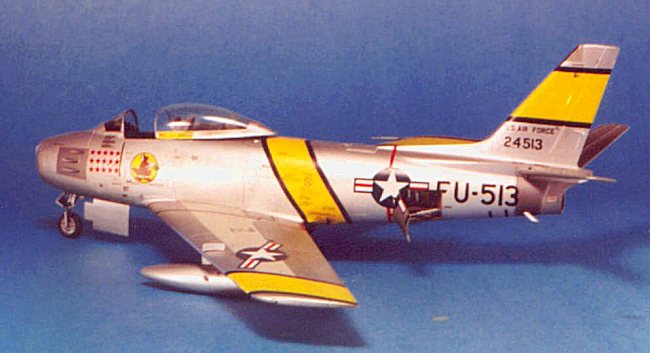
Hasegawa 1/48 F-86 Sabre 'Korean War'
|
KIT # |
PT 122 |
|
PRICE: |
$39.98 |
|
DECALS: |
See Review |
|
REVIEW BY: |
|
|
NOTES: |
Used Aries F-86 cockpit set |

|
HISTORY |
The North American F-86 "Sabre," like its predecessor, the P-51D Mustang, was fortuitous in its developmental history, and is one of those aircraft for which it can be said that had it not existed, history would be written differently today. The Sabre would definitely be among the Top Ten of the most significant fighter aircraft in history.
Fortunately for the United States, the Nazis were stupid enough to chase Edgar Schmued from Germany in 1938 with their policies. The immediate result two years later was the P-51 Mustang, which resulted from a design he had been toying with while working at Messerschmitt - his Mustang was more responsible than any other Allied fighter for the aerial destruction of Nazidom; the further result was that Schmued had no difficulty reading the captured German technical papers which discussed the advantage of the swept wing for jet powered aircraft as a way of delaying the onset of compressibility and therefore increasing speed; he had also been in attendance at the Volta Conference in 1935, and had left with a copy of Buseman's paper on the theoretical superiority of swept wings in high speed flight. The result was the Sabre.
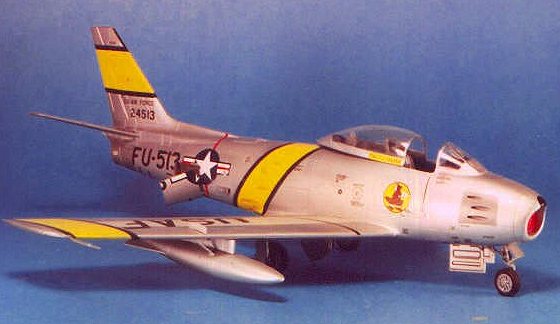 Unofficially, the Sabre
was the first supersonic aircraft, achieving a speed just in excess of Mach 1 in
a dive two weeks before Chuck Yeager "broke the sound barrier" in the
Bell X-1. The two aircraft in many ways were intertwined, because it was the
research performed by the X-1 that led to the creation of the "all flying
tail," which greatly eased an aircraft's penetration of the sonic barrier;
the Sabre was the first operational aircraft to which this was fitted. (Ed
note: this was first fitted to the F-86E which first saw operational use around
1951/52) As a result, the Sabre was faster, and more importantly more
controllable at those high speeds, than its Russian opponent, the MiG-15.
Unofficially, the Sabre
was the first supersonic aircraft, achieving a speed just in excess of Mach 1 in
a dive two weeks before Chuck Yeager "broke the sound barrier" in the
Bell X-1. The two aircraft in many ways were intertwined, because it was the
research performed by the X-1 that led to the creation of the "all flying
tail," which greatly eased an aircraft's penetration of the sonic barrier;
the Sabre was the first operational aircraft to which this was fitted. (Ed
note: this was first fitted to the F-86E which first saw operational use around
1951/52) As a result, the Sabre was faster, and more importantly more
controllable at those high speeds, than its Russian opponent, the MiG-15.
The Sabre was first ordered by the Air Force on August 30, 1944. At that time the design had a strong similarity to what would emerge from Republic's design department as the F-84 Thunderjet. Fortunately, in August 1945 Lee Atwood and Ray Rice were willing to listen to Schmued's descriptions of the German papers before they were officially translated. Armed with this information, Atwood went to the Air Force and got a year's delay on the delivery date of the XP-86, time enough to add in the swept wings. It was likely the most useful and important delay in aviation history. Had this not happened - had the F-86 come out of the shop looking like a slimmed down version of its naval counterpart, the FJ-1 Fury - the results of the aerial battles over Korea a few years later would have been very different indeed.
The F-86A Sabre had only been operational for a year when it went to war. The appearance of the MiG-15 over the Yalu River in North Korea in early November 1950 sent shivers through the Air Force - the unknown Russian jet was superior to everything in the inventory other than the possible likelihood of the Sabre. Within a month, the 4th Fighter Interceptor Wing - the descendant of the Eagle Squadrons and the 4th Fighter Group of World War II fame - was flying combat missions out of Suwon, Korea. For the next year, a force of Sabres that was never greater than 35-40 operational aircraft held off a Communist air command of several hundred jet fighters. The F-86A was followed a year later by the F-86E with the "all flying tail," and a bit less than a year after that by the F-86F which had an uprated engine and an extended wing leading edge without slats, for upgraded high speed performance.
It is alleged that the Sabre achieved a kill ratio of 12.5:1 against the MiG-15. This has since been lowered to around 4.5:1 in the light of access to Soviet records after the end of the Cold War. In fact, the MiG-15 was generally superior to the F-86 above about 38,000 feet and could top out at 50,000 feet, which was superior to the Sabre's operational ceiling; the MiG-15 was always at least the Sabre's equal in climb and turn radius. What won the war for the Sabres was the edge provided by the greater skill and experience of its pilots, many of who were aces of the Second World War, and all of whom were better-trained than their Communist opponents.
Two Korean Sabres:
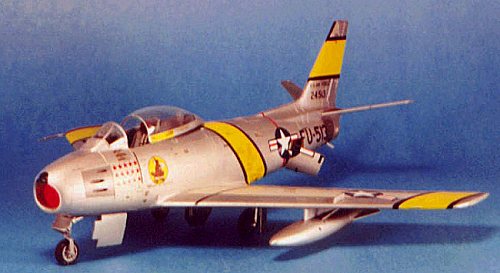 The first official USAF
Sabre "ace" was CAPT (later MAJ) James J. Jabara, who achieved his 5th
and 6th kills May 20, 1951. In the spring of 1953, Jabara became the only ace to
fly a second tour, returning to the 334th FIS of the 4th FIW in late April 1953.
The Sabres were "turned loose" on the enemy in May, 1953, at which
time an "ace race" began between Jabara, his fellow 334th pilot CAPT
Manuel "Pete" Fernandez, and CAPT Joseph McConnell from the 39th FIS,
51st FIW. The race began in May with Fernandez in the lead, followed by Jabara
and McConnell who jockeyed back and forth. In the end, it was McConnell by a
nose to become the UN Ace of Aces with 16 kills, followed by Jabara with 15 and
Fernandez with 14.5.
The first official USAF
Sabre "ace" was CAPT (later MAJ) James J. Jabara, who achieved his 5th
and 6th kills May 20, 1951. In the spring of 1953, Jabara became the only ace to
fly a second tour, returning to the 334th FIS of the 4th FIW in late April 1953.
The Sabres were "turned loose" on the enemy in May, 1953, at which
time an "ace race" began between Jabara, his fellow 334th pilot CAPT
Manuel "Pete" Fernandez, and CAPT Joseph McConnell from the 39th FIS,
51st FIW. The race began in May with Fernandez in the lead, followed by Jabara
and McConnell who jockeyed back and forth. In the end, it was McConnell by a
nose to become the UN Ace of Aces with 16 kills, followed by Jabara with 15 and
Fernandez with 14.5.
The markings for Jabara's last F-86F-5 were originally available in the ESCI kit of the Sabre, and are also available on one of Aeromaster's F-86 sheets.
Several exchange pilots from the USN, USMC, RAF and RCAF flew with the 39th Fighter Interceptor Squadron of the 51st Fighter Interceptor Wing, the second unit to be equipped with the Sabre in Korea (this increase in fighter power was only achieved by a threat from the Commander of the 4th FIW, COL Harrison Thyng, to resign his commission and go home to make public the real facts of the air war in the summer of 1952, when there were fewer than 30 operational Sabres in the Korean theatre). It has been alleged that the USAF maneuvered the assignments to keep these exchange pilots from achieving 5 kills, since the Air Force wanted to keep "acedom" in its own ranks. Only one of these pilots, MAJ John F. Bolt, USMC, broke the rule to achieve 6 kills. The second leading Marine pilot was MAJ John Glenn, a pilot who would become well-known in the immediate post-Korean period for a series of speed records, and would become even better known at the end of the decade as the first American to orbit the earth as an astronaut in the Mercury program. Glenn had three kills, which justified his airplane's big gaudy name, "MiG-Mad Marine."
Glenn's markings are available on an out of production SuperScale sheet, and also as the kit markings for one of Hasegawa's limited releases of their Sabre kit, PT122 - "F-86 Sabre 'Korean War."
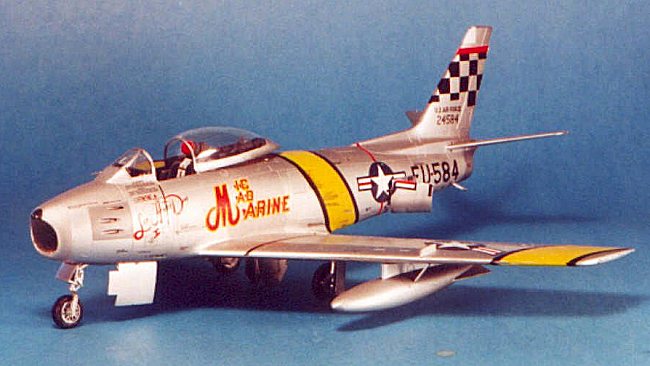
|
THE KIT |
The Sabre was released by Hasegawa in 1996. Prior to this, the only 1/48 Sabres were a kit released by Monogram in the mid-1970s, and one released a few years later by ESCI. The Monogram kit was and is good for its time; the ESCI kit is a mish-mash of F-86E and F-86F features, and requires a bit of work by the modeler to turn it into a model of one or the other airplanes. The Monogram kit was released in various versions differing by decals, which included a set of markings for an F-86 flown by Erich Hartman as CO of JG2 "Richtofen" in the West German Luftwaffe, while the ESCI kit includes markings for Jabara's Sabre, an F-86F flown by 2 Squadron SAAF in Korea, an Italian Sabre Mk.4, a Spanish F-86F and a Canadair Sabre Mk.6.
The Hasegawa offering comes in the now-standard medium gray flash-free plastic with neatly-engraved panel lines. The big canopy is well-molded in clear plastic. The only failing of the kit is that it has the intake just ahead of the starboard dive brake which was only found on the F-86F-40. This is a problem easily solved with an Xacto blade.
The cockpit is disappointing. This is the standard less-than-completely-detailed Hasegawa offering. At a minimum it cries out for replacement of the very bare and basic ejection seat. KMC made a seat for the Sabre which is very good and can still be found at dealer's tables during shows. Jaguar makes a more complete cockpit with seat and tub, and Aires makes a resin cockpit with seat, which includes the gun bays. Currently, the Aires set is the only one in production, though the Jaguar set can also be found with dealers at shows. True Details also made a Sabre cockpit specifically for the Hasegawa kit; this is out of production now but some are still available through Squadron. Given how big and beautiful the canopy is, the cockpit cries out for additional detail whether the canopy is open or closed.
|
CONSTRUCTION |
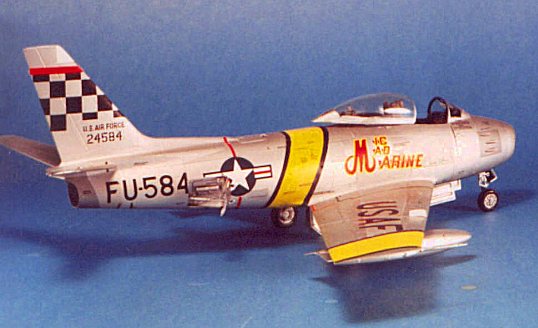 Construction is very
straightforward and has been gone into detail in other reviews here at Modeling
Madness. Suffice it here to say that anyone who can follow the very clear
instruction sheet should have no difficulty coming up with a pleasing result.
Construction is very
straightforward and has been gone into detail in other reviews here at Modeling
Madness. Suffice it here to say that anyone who can follow the very clear
instruction sheet should have no difficulty coming up with a pleasing result.
Be certain to dip the canopy in Future. Whether you close the canopy or slide it open, it just looks so much better with that additional shiny clarity. Jose Herculano points out at his Sabre Modeling Site (http://www.almansur.com/aviation/f86fdetail/) that there is a lack of detail in the Hasegawa kit for the area visible behind the seat when the canopy is open; if you get the Aires or Jaguar sets, this area is done correctly. My recommendation is that if you are using the kit cockpit with only a resin seat (or the kit seat) that you close the canopy. The model looks good that way, and it's easy to look inside and see all the detail that's there.
|
PAINT & DECALS |
Painting:
Doing a Korean War F-86 requires that one give it a natural metal finish. Not just a silver monotone, either, but rather a multi-hue finish. Here's how I did mine:
For starters, the center section of the wing is a greyed-out aluminum color. I did this with Tamiya Flat Aluminum and a bit of Tamiya Flat White, airbrushed in a very thin coat. When this was dry, these sections of the wings were masked off, and the rest of the airplane was airbrushed with SnJ aluminum paint. As I have said numerous times before with regard to a natural metal finish, SnJ is de rigeur; you put it on as the basecoat, and there is no problem with the other colors, since you can mask over SnJ with no fear of it coming off when the tape is lifted off. SnJ dries to touch in about 20 minutes and can be safely masked over after an hour.
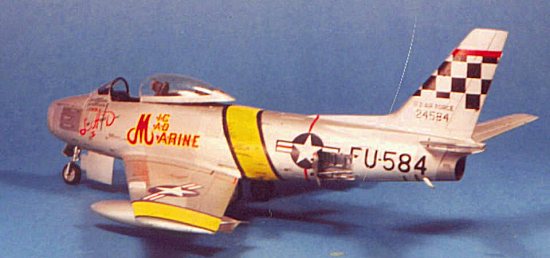 I then masked off the
panel with the guns and painted that with Testors ModelMaster Metalizer,
"Stainless Steel." At the same time, I masked off the section of the
rear fuselage just forward of the exhaust section, and also painted that
Stainless Steel. These were then sealed with ModelMaster Sealer. I then masked
off the exhaust section of the tail, and painted that with ModelMaster
"Magnesium," and sealed it. I then took off the drafting tape I use
for masking, and used some of the SnJ aluminum polishing powder on some of the
various panels along the fuselage, and for the nose cone. I buffed each of these
areas a bit to bring them into a different tonality than the SnJ paint.
I then masked off the
panel with the guns and painted that with Testors ModelMaster Metalizer,
"Stainless Steel." At the same time, I masked off the section of the
rear fuselage just forward of the exhaust section, and also painted that
Stainless Steel. These were then sealed with ModelMaster Sealer. I then masked
off the exhaust section of the tail, and painted that with ModelMaster
"Magnesium," and sealed it. I then took off the drafting tape I use
for masking, and used some of the SnJ aluminum polishing powder on some of the
various panels along the fuselage, and for the nose cone. I buffed each of these
areas a bit to bring them into a different tonality than the SnJ paint.
When all was finished, I sealed the entire airplane with a thin coat of Future.
Getting the Cockpit Color Right:
It should be noted that I painted each of the cockpits of these two models in a medium grey, with black instrument panels, etc. I have recently discovered that Sabres used during the Korean War had cockpits that were overall flat black; the grey color was entire a post-war phenomenon. So, if you're doing a Korean War Sabre, remember: the entire cockpit is flat black with some color for various dials and switches, and differing colors for the seat pads, straps, etc. Check your references for these.
Decals:
Both the Hasegawa kits used for these models provide the Korean-era yellow ID bands for the fuselage and wings as decals. However, they are a bit too lemon in tone. I had a sheet of yellow decal from SuperScale that was the proper shade. I cut out the yellow sections from the kit decals, and used these to create those sections from the SuperScale sheet, using the remains of the kit decals for the black stripes that edge these markings.
"MiG-Mad Marine":
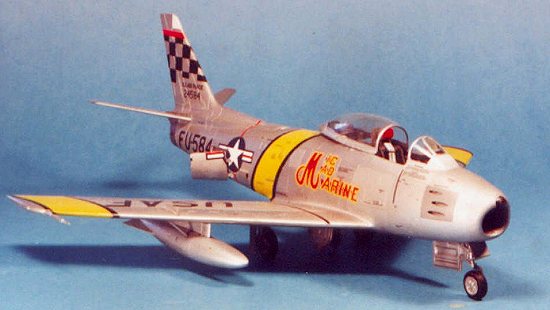 For "MiG-Mad
Marine," the Hasegawa marking for the very gaudy name is too dark in the
red areas and too light in the yellow. I was fortunate to have picked up the
SuperScale sheet when it came out a few years back, and used those decals for
the personal markings. The rest of the kit decals were fine and were used
throughout. I am sure that if you cannot find the SuperScale sheet (I also think
this may have been re-done by Aeromaster a while back), the kit markings would
be more than acceptable.
For "MiG-Mad
Marine," the Hasegawa marking for the very gaudy name is too dark in the
red areas and too light in the yellow. I was fortunate to have picked up the
SuperScale sheet when it came out a few years back, and used those decals for
the personal markings. The rest of the kit decals were fine and were used
throughout. I am sure that if you cannot find the SuperScale sheet (I also think
this may have been re-done by Aeromaster a while back), the kit markings would
be more than acceptable.
J.J. Jabara's Sabre:
I used the decals from an old ESCI Sabre sheet to do this model. I believe the markings are also provided on an Aeromaster sheet from a few years ago; this is likely to be out of production now. At any rate, the major drawback of the ESCI decals is they are flat-finish. I sprayed a coat of Future over them to get rid of that (and at the same time protect them from coming apart, since they were more than a few years old). I then cut the individual markings (buzz number, serial number, squadron marking, scoreboard, and name shield) out and they went on easily. All the rest of the standard Sabre markings came from the Hasegawa decal sheet.
Final Finish:
I used the drop tanks from the kit, and attached these after I attached the landing gear.
My final bit of weathering was to shoot the airplane with a light coat of "flat Future" to dull down the natural metal finish as it would be when an aircraft is left in the open - as Sabres were in Korea. I airbrushed a bit of Testor's Dullcote to emphasize this in areas where there would be foot traffic or increased handling during servicing.
|
CONCLUSIONS |
I think the Sabre is one of the best-looking fighters ever made, period; it only gets a run for its aesthetic money from the Hawker Hunter of any jet from its generation. It stands in historic importance with the Sopwith Camel, the Supermarine Spitfire, the North American Mustang and the Grumman Hellcat as being absolutely essential to creating the history of the world we live in.
If you would like your product reviewed fairly and fairly quickly by a site that has over 1,100 visits a day, please contact the editor or see other details in the Note to Contributors.